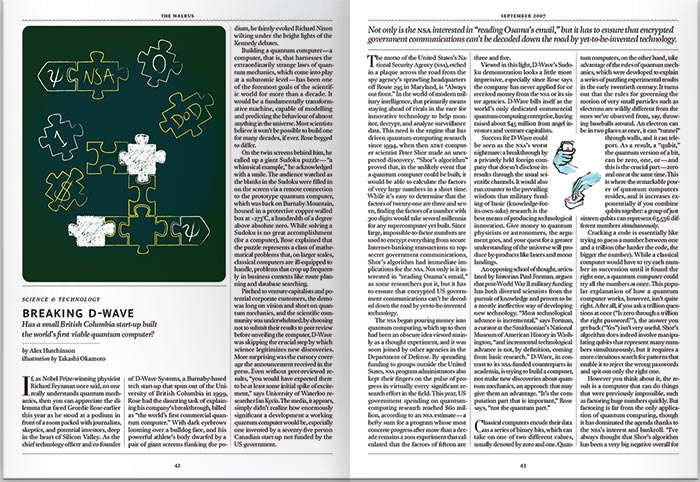
D-Wave Systems may have a jetpack problem, but it is not the one critics anticipated. When I wrote about the small Burnaby, BC, company in these pages in September 2007, it had just demonstrated what it billed as the world’s “first commercially viable quantum computer”—a bold claim, I pointed out, considering that quantum computing had been “one of the foremost goals of the scientific world for more than a decade.” While the prototype’s greatest feat was solving a Sudoku puzzle, the developers hoped to have a version by late 2008 that could tackle real-world problems, from route planning to molecular modelling, at speeds that would soon outstrip any conventional computer in existence. That’s the standard jetpack playbook: a whiz-bang new technology that will change your life but remains just around the corner for years, until it becomes a running joke.
D-Wave seemed to follow that pattern to a T, as the years and self-imposed deadlines slipped past. Naysayers—and they were plentiful and vocal—doubted that even the initial prototype was truly “quantum.” While conventional computers store information as bits that can be either zero or one, quantum computers derive their power from the strange rules of quantum mechanics, which allow qubits to be a mix of zero and one at the same time. But the upstart start-up offered no evidence that its qubits actually performed this mind-bending feat. Focused on the technology’s commercial viability, D-Wave snubbed the conventions of peer-reviewed science and simply asked investors to trust them.
The tide began to turn in 2011: first, D-Wave published evidence of quantum effects in Nature, one of the world’s premier science journals. Two weeks later, the company announced that Lockheed Martin had purchased a 128-qubit machine (the prototype had sixteen qubits) for a reported $10 million, with the goal of reducing the billions it spends verifying computer code for fighter jets and other complex projects. “Big Win for the Losers at D-Wave” read the headline in one engineering magazine, which had singled out the company for criticism in 2010. The machine has since produced further evidence of quantum behaviour, and in March of this year it was reported that Lockheed would upgrade to a 512-qubit D-Wave Two.
In one sense, then, the jetpack has finally arrived. There is little doubt that D-Wave has built some sort of quantum computing machine. In a cruel twist, though, that may not be enough. Such are the vagaries and complexities of quantum theory that it remains unclear whether the new design will actually be faster than conventional computers. The only way to find out will be to build ever-bigger models until one demonstrates its superiority—or doesn’t. If it does, then D-Wave’s headlong try-it-and-see approach will be vindicated, perhaps very, very richly. If not… well, that’s how the jetpack story ultimately played out: you finally manage to build your dream machine, and it turns out no one has any use for it.
UPDATE D-Wave’s momentum continues to build: on May 16, the company announced that NASA, Google, and the Universities Space Research Association have purchased a D-Wave Two computer. Installation has already begun at NASA’s Ames Research Center in California.
This appeared in the July/August 2013 issue.




